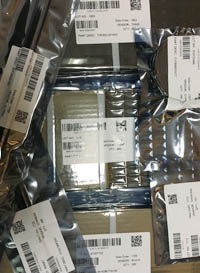| Part Number | AD8036ANZ |
|---|---|
| Manufacturer | Analog Devices Inc. |
| Description | IC OPAMP VFB 240MHZ 8DIP |
| Datasheet | |
| Package | 8-DIP (0.300", 7.62mm) |
| ECAD |
|
| In Stock | 14,844 piece(s) |
| Unit Price | $ 21.1947 * |
| Lead Time | Can Ship Immediately |
| Estimated Delivery Time | Apr 28 - May 3 (Choose Expedited Shipping) |
| Request for Quotation |
|
| Payment Methods | |
| Delivery Services |
Part Number # AD8036ANZ (Linear - Amplifiers - Instrumentation, OP Amps, Buffer Amps) is manufactured by Analog Devices Inc. and distributed by Heisener. Being one of the leading electronics distributors, we carry many kinds of electronic components from some of the world’s top class manufacturers. Their quality is guaranteed by its stringent quality control to meet all required standards.
For AD8036ANZ specifications/configurations, quotation, lead time, payment terms of further enquiries please have no hesitation to contact us. To process your RFQ, please add AD8036ANZ with quantity into BOM. Heisener.com does NOT require any registration to request a quote of AD8036ANZ.
Brid*****Gentry
March 21, 2023
Kai***** Sosa
March 16, 2023
Celi*****nchal
March 13, 2023
Jemm*****tson
February 28, 2023
Jay***** Meza
February 26, 2023





We guarantee 100% customer satisfaction.
Our experienced sales team and tech support team back our services to satisfy all our customers.

We provide 90 days warranty.
If the items you received were not in perfect quality, we would be responsible for your refund or replacement, but the items must be returned in their original condition.
| Part Number | Manufacturer | Description | Stock |
AD8036ANZ D# V99:2348_06213337 |
Analog Devices Inc |
Op Amp Single Clamping Amplifier ±6V 8-Pin PDIP N Tube RoHS: Compliant
|
0 |
| Part Number | Manufacturer | Description | Stock |
AD8036ANZ |
Analog Devices Inc | 3 |
| Part Number | Manufacturer | Description | Stock |
AD8036ANZ |
Analog Devices Inc |
AMP DUAL VIDEO FEEDBACK, 8036, DIP8 |
31 |
| Part Number | Manufacturer | Description | Stock |
AD8036ANZ D# AD8036ANZ-ND |
Analog Devices Inc |
IC OPAMP VFB 1 CIRCUIT 8DIP |
26 |
| Part Number | Manufacturer | Description | Stock |
AD8036ANZ |
Analog Devices Inc |
In stock shipping within 2days |
1000 |
| Part Number | Manufacturer | Description | Stock |
AD8036ANZ D# 1079409 |
Analog Devices Inc |
AMP DUAL VIDEO FEEDBACK, 8036, DIP8 RoHS: Compliant
Min Qty: 1
Container: Each
|
0 |
| Part Number | Manufacturer | Description | Stock |
AD8036ANZ |
Analog Devices Inc |
OEM/CM QUOTES ONLY | NO BROKERS |
54 |
| Part Number | Manufacturer | Description | Stock |
AD8036ANZND |
Analog Devices Inc |
OEM/CM ONLY |
1509 |
AD8036ANZ |
Analog Devices Inc |
OEM/CM ONLY |
452 |
| Part Number | Manufacturer | Description | Stock |
AD8036ANZ |
ADI Electronics Inc |
OEM/CM Immediate delivery |
950 |
| Part Number | Manufacturer | Description | Stock |
AD8036ANZ D# 584-AD8036ANZ |
Analog Devices Inc |
High Speed Operational Amplifiers VLTG-FDBK,G = 1 CLAMP AMP RoHS: Compliant
|
36 |
| Part Number | Manufacturer | Description | Stock |
AD8036ANZ D# NS-AD8036ANZ |
Analog Devices Inc |
OEM/CM ONLY |
2361 |
| Part Number | Manufacturer | Description | Stock |
AD8036ANZ |
Analog Devices Inc | 2 |
| Part Number | Manufacturer | Description | Stock |
AD8036ANZ D# 7097026 |
Analog Devices Inc |
AD8036ANZ Analog Devices, Low Noise, Op Amp, 8-Pin PDIP, EA Min Qty: 1
Container: Bulk
|
96 |
| Part Number | Manufacturer | Description | Stock |
AD8036ANZ |
Analog Devices Inc |
AD8036 - Operational Amplifier, 11000uV Offset-Max, BIPolar, PDIP8 RoHS: Compliant
|
17809 |
| Part Number | Manufacturer | Description | Stock |
AD8036ANZ |
Analog Devices Inc |
IN stock Immediate delivery |
945 |
| Part Number | Manufacturer | Description | Stock |
AD8036ANZ |
Analog Devices Inc |
shipping today |
292 |
| Part Number | Manufacturer | Description | Stock |
AD8036ANZ D# 26616739 |
Analog Devices Inc |
Op Amp Single Clamping Amplifier ±6V 8-Pin PDIP N Tube RoHS: Compliant
|
0 |
| Part Number | Manufacturer | Description | Stock |
AD8036ANZ |
Analog Devices Inc |
RFQ |
13209 |
| Part Number | Manufacturer | Description | Stock |
AD8036ANZ D# 1079409 |
Analog Devices Inc |
AMP DUAL VIDEO FEEDBACK, 8036, DIP8 RoHS: Compliant
Min Qty: 1
Container: Each
|
0 |
Heisener's commitment to quality has shaped our processes for sourcing, testing, shipping, and every step in between. This foundation underlies each component we sell.

Do you have any question about AD8036ANZ?
+86-755-83210559-827



Scan to view this page